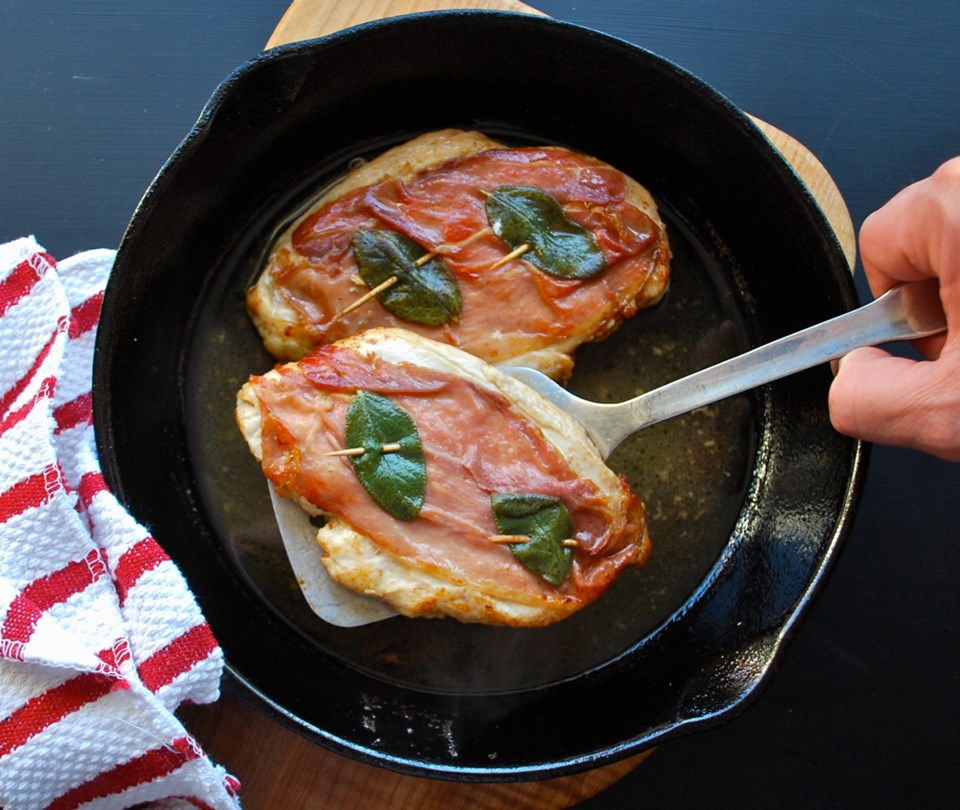As I was leafing through my collection of Italian cookbooks recently, I was reminded of why I truly enjoy preparing this cuisine. It’s because a number of recipes use only a handful of key ingredients to almost magically create a dish divine in flavour.
One good example is saltimbocca, pronounced “sahl-teem-BOH-kah.”
According to John Mariani’s book The Italian Dictionary of Food and Drink, saltimbocca translates as “leap in the mouth.”
That’s exactly what you want this dish to do, because it is very tasty.
Mariani writes that saltimbocca is most often associated with Rome. But he adds that Italian food authority Luigi Carnacina contends that saltimbocca originally came from Brescia, a city in the northern Italian region of Lombardy.
In making saltimbocca, thin pieces of veal are rolled up, or simply topped, with prosciutto. The latter is an aged, salt-cured, air-dried, dense ham that when thinly sliced has an almost silky texture and somewhat nutty flavour.
The prosciutto is then topped with whole fresh sage leaves, which add a wonderful aroma to the dish and an earthy, somewhat peppery, pine-wood taste.
In some recipes, the veal is lightly floured before it’s cooked in butter and olive oil. In others, it’s not. Either way, when the veal is cooked, it’s removed from the pan. A simple sauce to pour over the veal is then made in that pan, with dry white wine or Marsala, a fortified Sicilian wine.
When you eat saltimbocca, you soon discover why the cook who first made it determined that tender meat, prosciutto, sage and a wine-laced sauce did not need a whole bunch of other ingredients to enhance that combination’s already superb flavour.
You’ll also find versions of saltimbocca made with other mild-tasting types of boneless meat, such as pork cutlets or chicken breast.
I decided to use the latter in my recipe because, of course, chicken breast is widely available, unlike good veal, which is not as available in Victoria as it is in other 91ԭ�� cities. You can find it in a few locales, so in this recipe, I have given you the option to use it, if you prefer.
Chicken Saltimbocca
Mild-tasting chicken breast in this Italian-style recipe is richly flavoured with prosciutto, sage and wine. You can serve the chicken saltimbocca with such things as creamy polenta, orzo or boiled potatoes, and a green vegetable, such as broccolini, rapini, asparagus or green beans.
Preparation time: 20 minutes
Cooking time: About 12 minutes
Makes: Two servings
2 (7- to 8-oz.) boneless, skinless, chicken breasts (see Eric options)
• freshly ground black pepper, to taste
2 large, thin slices prosciutto
4 large fresh sage leaves
3 tsp butter (divided)
2 tsp olive oil
1/4 cup Marsala or dry white wine (see Note 1)
1/4 cup chicken stock or broth
Set the chicken breasts, smooth-side down, on a cutting board. Now, to make the chicken easier to pound into an even shape, remove the chicken fillet from each breast and save for another use, such as slicing and using in a stir-fry or pasta (see Note 2).
Turn each breast smooth-side up, then cover with plastic wrap. Use a kitchen hammer to pound the chicken until it’s about 1/4 inch in thickness. (When pounding the chicken, don’t do so too firmly, or it might break apart in places.)
Season the chicken with black pepper (the prosciutto will add a salty taste). Now set a piece of prosciutto and two sage leaves on each breast, securing the sage with wooden toothpicks.
Preheat oven to 200 F. Place 2 tsp of the butter and the olive oil in a large skillet set over medium, medium-high heat.
When the butter is melted and no longer foaming, set chicken in the skillet, prosciutto-side down, and fry until golden brown on that side, about three to four minutes.
Turn chicken over and cook three to four more minutes on the other side, or until cooked through.
Remove chicken from the skillet, put it on a heatproof plate and set in the oven.
Pour the Marsala (or white wine) and stock (or broth) in the skillet, bring to a simmer, and cook until reduced by a third.
Now whisk in the 1 tsp butter. Set chicken back in the skillet, prosciutto-side up, and heat through one to two minutes.
Set a piece of the chicken on each of two dinner plates. Carefully remove toothpicks from the chicken. Spoon the sauce in the skillet over the chicken and serve.
Note 1: Marsala is a fortified Italian wine available at most liquor stores.
Note 2: Chicken breast fillet is a strip of meat attached to the main part of the breast. It is loosely attached and can be easily pulled off.
Eric’s options: Instead of chicken breast, use two (6 oz.) veal cutlets in this recipe, pounded to a similar thickness.
Eric Akis is the author of eight cookbooks, including seven in his Everyone Can Cook series. His columns appear in the Life section Wednesday and Sunday.



